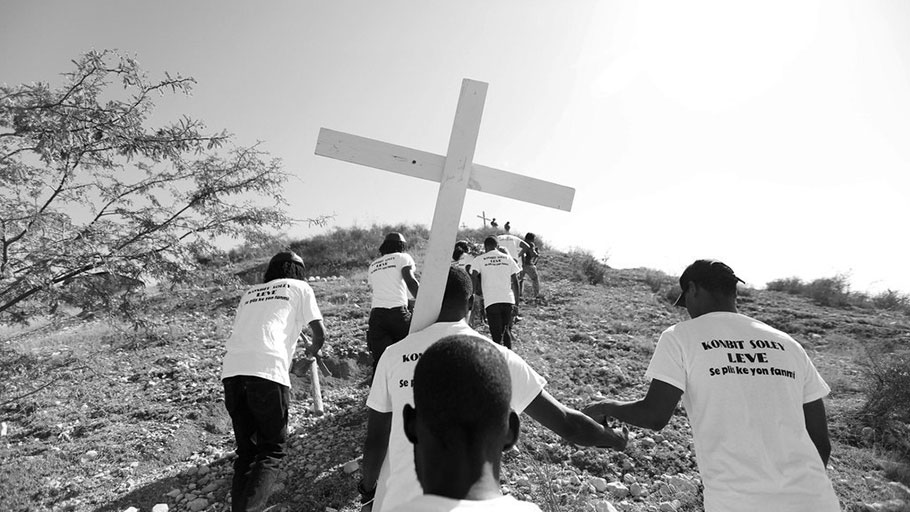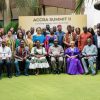Mourners carry a cross in Port-au-Prince, in January, 2019, to honor the victims of the 7.0-magnitude earthquake that devastated Haiti on January 12, 2010. Photograph by Jeanty Junior Augustin, Reuters.
By Edwidge Danticat, The New Yorker —
This past December, as what would have been my mother’s eighty-fourth birthday approached, I kept dreaming of death. In the most frequent of these dreams, my mother, who died, of ovarian cancer, in October, 2014, in Miami, is telling me to run out of the single-story house where I spent most of my childhood, in Port-au-Prince, before the house falls on top of me and several members of my family.
I knew why I was having these dreams. The anniversary of the 7.0-magnitude earthquake that struck Haiti on January 12, 2010—levelling parts of Port-au-Prince and the surrounding areas, and leading to thousands of deaths, including those of several friends and family members—was coming. And sometimes anniversaries hurt. You feel them in inexplicable aches in your body, or in a general unease that you keep trying to shake until you realize, yes, it is that time of year. Again.
This past year, there has been a lot more than usual to worry about. Haitians have been protesting against President Jovenel Moïse since July 6, 2018. They have been demonstrating against fuel hikes, corruption, and other systemic problems, such as high rates of unemployment, spiking inflation, currency devaluation, and extrajudicial killings, some of which have been linked to government officials. Between September and early December, 2019, the country was on an extended lockdown, or peyi lòk. Forty-two protesters were reported to have died during that time, and more than eighty injured. Nearly two million students could not go to school. Health care, already a challenge, became harder to access. Gang violence has intensified. Greater food insecurity looms ahead. The President refuses to resign. Haitian opposition leaders, some belonging to Moïse’s own political party, have vowed to keep protesting, but most parliamentarians’ terms will expire on January 13th, and, since no legislative elections have been held, the President can soon rule by decree.
This is only one snapshot of the Haiti that will commemorate the tenth anniversary of its most catastrophic natural disaster this Sunday. For some Haitians, in addition to navigating the country’s current and chronic problems, the anniversary might make them feel as though they’re still being attacked, both literally and figuratively, by the soil. This is how one older family member who survived the earthquake once described the early, single-digit anniversaries to me. This is how I imagine one younger relative might have felt after losing several toes to part of a collapsed wall in the earthquake, only to nearly die again last year after being shot by another young man who wanted his motorcycle.
Sorrowful anniversaries magnify absence. I think of a story often shared by Marie Guerda Nicolas, a Haitian-American clinical-psychology professor at the University of Miami School of Education and Human Development, and one of the founders of Rebati Santé Mentale, an organization collaborating with mental-health workers in Haiti. Soon after the earthquake, Nicolas was in the western coastal town of Léogâne, my mother’s birthplace and the epicenter of the quake. Nicolas met a woman who, after searching with other distraught parents through the rubble of her eight-year-old daughter’s school, found one of her daughter’s legs, which she recognized by the style and color of the shoes and socks the girl had been wearing that day. The woman took the leg home, washed it, and laid it on her daughter’s still-intact bed. Eventually, Nicolas persuaded the woman to bury the leg.
I think, too, of a discussion I had with family members in Port-au-Prince when they called to inform me that a loved one’s torso had been found. The decision was made to bury him immediately near the site where he’d died, but the horror of suddenly spotting his favorite shirt, after days of searching for him in the rubble, still haunts his surviving children.
Sorrowful anniversaries also inevitably make us wonder what might have been. What if three hundred and sixteen thousand people—the death count, according to government estimates—had not perished? What might they have contributed to their communities, their country? What if Haiti had actually been “built back better,” as President Bill Clinton, who served in a triple role as United Nations Special Envoy for Haiti, international co-chair of the Interim Haiti Recovery Commission, and one of the two Presidential faces of the Clinton Bush Haiti Fund, had often promised? What if the $13.5 billion in pledged and donated funds had actually been disbursed and invested in improving the lives of most Haitians, creating genuine paths for a better future? What if more seismic-resistant homes, hospitals, schools, and universities had been built, or rebuilt, to reduce future casualties? What if rural entrepreneurs, women’s organizations, and peasant farmers—who face the brunt of diminishing food production, environmental degradation, deadly hurricanes, and climate change—had been integral players in the reconstruction plans? What if . . . ?
Many of my family members in Haiti often refer to the country’s current political and economic challenges as another earthquake, one with no foreseeable end. I was in a supermarket in Miami’s Little Haiti neighborhood on the afternoon of January 12, 2010, when news of the earthquake broke. I tried calling friends and family members in Haiti, and then I called my mother, in New York. Between crying and praying, she, too, was trying to reach everyone she knew in Port-au-Prince and Léogâne.
“What will the country be like now?” she kept asking me, something she did each time yet another tragedy had befallen Haiti. “Ten, twenty years from now, what will the country be like?” On this anniversary, like all the others to follow, Haitians must ultimately decide.
This article was originally published by The New Yorker.
Edwidge Danticat is the author of many books, including, most recently, “Everything Inside: Stories.”















